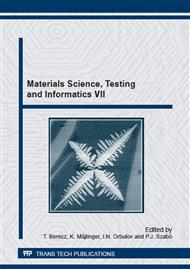p.83
p.89
p.95
p.101
p.107
p.113
p.119
p.125
p.131
Surface Hardening of Austenitic Stainless Steel by Explosive Treatment
Abstract:
Specimens of austenitic stainless steel hardness changing were tested. The used hardening technology was a modified explosive treatment. During the hardening tests the explosive exploded different distance from surface. Same setup was tested with 2, 3 and 4 mm holder. The hardness improving and the plastic deformation were different as function of the holder size. The hardness was measured by Vickers hardness tester. The amount of strain induces martensite was detected magnetically. It can suppose that the microstructure changed during high rate strain. Results showed that the strain rate and result hardness depend on the holder size. We found that the bigger holder size in case of the tested setup provoke higher hardening. To determine the hardness properties it’s important to use an optional setup.
Info:
Periodical:
Pages:
107-111
Citation:
Online since:
February 2015
Authors:
Price:
Сopyright:
© 2015 Trans Tech Publications Ltd. All Rights Reserved
Share:
Citation:


